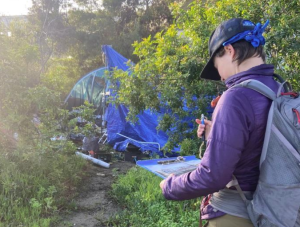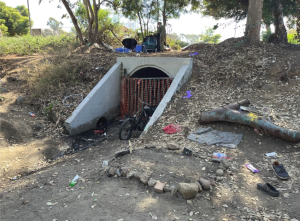Study quantifies fecal pollution from unhoused populations

SCCWRP and its partners have completed a first-of-its-kind study estimating the degree to which people experiencing homelessness along the San Diego River contribute to fecal contamination downstream – one in a series of studies probing the role of various potential sources of fecal contamination polluting the urbanized watershed.
The study, described in a journal article published earlier this year, found that people experiencing homelessness likely contribute a small fraction of the total levels of human fecal contamination measured at the end the watershed.
During wet weather, human fecal contamination is widespread in the San Diego River watershed. Given that an estimated 180,000 people experienced homelessness in California in 2023, some environmental managers have questioned if the unhoused population could be a potentially significant source of human fecal pollution in waterways. However, until this study, few attempts had been made to comprehensively quantify the contribution of this population to fecal contamination in an urban watershed.
This study represents one of multiple SCCWRP-led investigations probing various potential sources of fecal contamination to the San Diego River watershed. Researchers also are investigating the potential contributions of exfiltration from public sewers and private lateral lines, illegal connections and illicit discharges, leaks from onsite wastewater treatment systems, and sanitary sewer overflows.
Findings from all of these other studies are scheduled to be released in June, including a report estimating the relative contributions of each of these sources to fecal contamination loading during wet weather.
For the study of unhoused populations, researchers began by conducting multiple censuses to count all of the individuals living along the San Diego River during the rainy season when fecal contamination along the river is greatest. A few hundred individuals live along the river in winter, according to the census.
Researchers surveyed 63 people face-to-face who were living along the San Diego River corridor and its tributaries to document their sanitary habits, including how often they defecated outside and if or how they contained and disposed of their fecal material.
While nearly all individuals responded that they defecate outside, about 75% reported using buckets or bags to contain and remove fecal material from the river corridor. Only a single person reported defecating directly into the river.
Based on this information, researchers estimated the levels of fecal contamination that these populations could be contributing to the watershed.

Researchers also repeated the analysis with worst-case scenarios – such as if every individual used the river as a toilet – to probe how the fecal contamination loading estimates would change.
In all cases, the fecal loading generated by this population could not explain the high levels of human fecal contamination levels measured at the coastal terminus of the San Diego River watershed – suggesting that other sources must also be contributing to the observed fecal contamination.
To investigate whether the study could have under- or over-counted unhoused people living along the San Diego River, researchers also compared the study’s census data to an independent count of encampments along the river. The encampment counts mirrored the census data – which can vary based on weather, enforcement, or availability of services – adding confidence that the SCCWRP data did not miss large spikes or dips in population.
For more information, contact Dr. Joshua Steele or Ken Schiff.
More news related to: Microbial Source Tracking, Microbial Water Quality, Top News